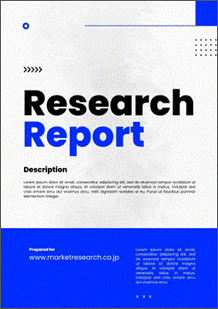 | • レポートコード:MRC2203A630 • 出版社/出版日:Mordor Intelligence / 2022年3月15日 • レポート形態:英文、PDF、130ページ • 納品方法:Eメール(受注後2-3営業日) • 産業分類:農業 |
| Single User | ¥703,000 (USD4,750) | ▷ お問い合わせ |
| Site Licence | ¥962,000 (USD6,500) | ▷ お問い合わせ |
| Corporate License | ¥1,295,000 (USD8,750) | ▷ お問い合わせ |
• お支払方法:銀行振込(納品後、ご請求書送付)
レポート概要
| Mordor Intelligence社は、2019年に76.2億ドルであった世界の農業用生物学的製剤市場規模が、予測期間中に年平均12.8%成長すると予測しています。本調査資料では、農業用生物学的製剤の世界市場について調査・分析し、イントロダクション、調査手法、エグゼクティブサマリー、市場動向、機能別(生物的防除、バイオ肥料、生体刺激剤)分析、製品別(微生物、マクロバイアル、天然物、その他)分析、用途別(葉面散布、種子処理、土壌処理)分析、作物別(穀類、油糧種子・豆類、果物・野菜、その他)分析、地域別(北米、ヨーロッパ、アジア太平洋、南米、アフリカ)分析、競争状況、市場機会・将来の傾向などの項目を掲載しています。 ・イントロダクション ・調査手法 ・エグゼクティブサマリー ・市場動向 ・世界の農業用生物学的製剤市場規模:機能別(生物的防除、バイオ肥料、生体刺激剤) ・世界の農業用生物学的製剤市場規模:製品別(微生物、マクロバイアル、天然物、その他) ・世界の農業用生物学的製剤市場規模:用途別(葉面散布、種子処理、土壌処理) ・世界の農業用生物学的製剤市場規模:作物別(穀類、油糧種子・豆類、果物・野菜、その他) ・世界の農業用生物学的製剤市場規模:地域別(北米、ヨーロッパ、アジア太平洋、南米、アフリカ) ・競争状況(UPL Limited、Bayer CropScience AG、Corteva AgriScience、...) ・市場機会・将来の傾向 |
The agricultural biologicals market was valued at USD 7.62 billion in 2019, and it is estimated to record a CAGR of 12.8% during the forecast period.
Key Highlights
- Agricultural biologicals are the seed treatment products that are used to replace chemicals in farming, which are mainly used to prevent the crops from pests, weeds, and diseases, in order to maintain crop health.
- The rise in awareness among farmers, increased pest outbreaks in crops, need to increase the yield of the crops, and developments in pest-resistance products are some of the major reasons for the growth of the market.
Key Market Trends
Favorable Regulatory Structure
Given that biopesticides tend to pose fewer environmental risks compared to chemical pesticides, the US Environmental Protection Agency (USEPA) generally requires less stringent data to register a biopesticide than chemical pesticide. As a result, new biopesticides are often registered in less than a year, compared to an average of more than three years for chemical pesticides. Biopesticides are regulated in the European Union in the same manner as chemical pesticides. The Organization for Economic Co-operation and Development (OECD), a 34-country group headquartered in Paris, France, assists EU in a quick and thorough assessment of biopesticide for eliminating risks to humans and the environment.
To promote the use of biopesticides, even developing countries, such as India, have simplified the requirement for the registration of biopesticides. The National Farmer Policy in India also strongly recommended the use of biopesticides across the country. All these activities are creating an opportunity for the development of biopesticides, globally. In the United States, the registration process for biofertilizers is done at the state level, and they are registered under soil amendments, as they contain organic components. In Canada, the Canadian Food Inspection Agency (CFIA) has well-defined processes for the registration of biofertilizers. This practice allows biofertilizer companies to operate in a safe environment and attract new investors in the biofertilizer industry.
United States Dominates the Market
According to the data of the US Department of Agriculture’s Agricultural Statistics Service, there were more than 1,400 registered organic farms in the Unites States in 2016. Furthermore, around 3,454,441 acres of land was treated with biological fertilizers in 2017. Organic exports of fruits and vegetables amounted to USD 548 million in 2016. Hence, the increasing demand for organic crops is leading to an upsurge in the demand for biological products in the country. The US Environmental Protection Agency (EPA), which is associated with the regulation of pesticides in the United States, has made the registration of biopesticide products more efficient through the development of modified test methodologies and clear guidance documents, as a result of which, currently, over 430 biopesticide ingredients are available in the country.
The major strategies adopted by key players, such as Certis USA LLC, Syngenta, Bayer CropScience AG, and BASF SE, have also contributed to the growth of the agricultural biologicals market in the country. For instance, in 2017, Agrinos and Van Diest Supply Company partnered to drive the use of biological crop solutions among the farmers in the country.
Competitive Landscape
In the agricultural biologicals market, companies are not only competing based on product quality and promotion but also focusing on strategic moves, in order to hold larger market shares. New product launches, partnerships, and acquisitions are the major strategies adopted by the leading companies in the market. Companies are investing heavily in developing new products and are collaborating and acquiring other companies, which is expected to increase their market shares and strengthen the R&D activities. Involvement in agreements with other agricultural biological product and technology providers is one of the most prominent strategies followed by market leaders, worldwide.
In 2016, Agrinos set up a new production facility in the United States. Lallemand Plant Care, a business unit of Lallemand Inc., acquired BioBoost and BYSI-N, the biological line of BrettYoungt, in June 2017.
Additional Benefits:
- The market estimate (ME) sheet in Excel format
- 3 months of analyst support
1 INTRODUCTION
1.1 Study Deliverables
1.2 Study Assumptions
1.3 Scope of the Study
2 RESEARCH METHODOLOGY
3 EXECUTIVE SUMMARY
4 MARKET DYNAMICS
4.1 Market Overview
4.2 Market Drivers
4.3 Market Restraints
4.4 Porter’s Five Force Analysis
4.4.1 Threat of New Entrants
4.4.2 Bargaining Power of Buyers/Consumers
4.4.3 Bargaining Power of Suppliers
4.4.4 Threat of Substitute Products
4.4.5 Intensity of Competitive Rivalry
5 MARKET SEGMENTATION
5.1 Function
5.1.1 Biocontrol
5.1.2 Biofertilizers
5.1.3 Biostimulants
5.2 Product Type
5.2.1 Microbials
5.2.2 Macrobials
5.2.3 Natural Products
5.2.4 Others
5.3 Application
5.3.1 Foliar Spray
5.3.2 Seed Treatment
5.3.3 Soil Treatment
5.4 Crop Type
5.4.1 Cereals & Grains
5.4.2 Oilseeds & Pulses
5.4.3 Fruits & Vegetables
5.4.4 Others
5.5 Geography
5.5.1 North America
5.5.1.1 United States
5.5.1.2 Canada
5.5.1.3 Mexico
5.5.1.4 Rest of North America
5.5.2 Europe
5.5.2.1 Germany
5.5.2.2 United Kingdom
5.5.2.3 France
5.5.2.4 Russia
5.5.2.5 Spain
5.5.2.6 Rest of Europe
5.5.3 Asia-Pacific
5.5.3.1 India
5.5.3.2 China
5.5.3.3 Japan
5.5.3.4 Rest of Asia-Pacific
5.5.4 South America
5.5.4.1 Brazil
5.5.4.2 Argentina
5.5.4.3 Rest of South America
5.5.5 Africa
5.5.5.1 South Africa
5.5.5.2 Rest of Africa
6 COMPETITIVE LANDSCAPE
6.1 Most Adopted Strategies
6.2 Market Share Analysis
6.3 Company Profiles
6.3.1 UPL Limited
6.3.2 Bayer CropScience AG
6.3.3 Corteva AgriScience
6.3.4 Syngenta International AG
6.3.5 BASF SE
6.3.6 Novozymes AG
6.3.7 Atlántica Agricola
6.3.8 W. Neudorff GmbH KG
6.3.9 Agrinos AS
6.3.10 FMC Corporation
6.3.11 Certis USA LLC
6.3.12 Bioworks Inc
6.3.13 Kiwa Bio-tech Products Group Corporation
6.3.14 International Panaacea Limited
6.3.15 Andermatt Biocontrol AG
7 MARKET OPPORTUNITIES AND FUTURE TRENDS